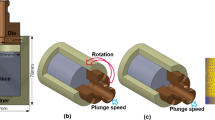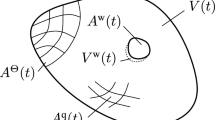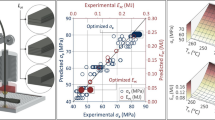Abstract
Efficiency of coin manufacturing is often limited by the service life of the stamping dies, whose degradation by wear results in decreasing the quality of the produced coin engraving. The aim of this work is to explore the ability of the combined application of experimental characterization and numerical simulation of the material elastoplastic forming response, friction effects, and die material wear rate as a tool to contribute to the coin design in order to ultimately increase the number of coins that can be die forged before the use of a worn die compromises the desired quality of the final product. The following aspects have been particularly addressed in this study. First, the influence of two design parameters related with the quality of the coins, i.e., die displacement and depth of engraving, is quantified determining that the die displacement is the most preponderant since the stamping force needed in this process is higher compared with that obtained by varying the depth of engraving. In addition, it is found that the curvature of the coin relief determines the local stress distribution, in some cases even at the opposite die, resulting in a heterogeneous wear evolution. A complementary wear test reveals that, for the involved range of curvatures, the wear mechanism may shift from dominated by plowing/cutting to dominated by fatigue. It is concluded that the numerical simulation allows considering efficiency of the coining process already at the stage of the aesthetic design of a coin.















Similar content being viewed by others
References
Buffa G., Fratini L., Micari F. (2007) The relevance of the preform design in coining processes of cupronickel alloy. AIP Conference Proceedings 908:1005
Geiger M., Kleiner M., Eckstein R., Tiesler N., Engel U. (2001) Microforming. Annals of the CIRP 50(2):445–462
Zheng W., Wang G., Lin X., Tang B., Huang L., Qing W., Sun Y. (2014) The experimental investigation of size effect on micro-cylinder deformation in coining process. Materials and Manufacturing Processes 29:687–690
Ike H., Plancak J. (1998) Coining process as a means of controlling surface microgeometry. Journal of Material Processing Technology 80-81:101–107
Xu J.P., YQ Liu Y.Q., Li S.Q., Wu S.C. (2008) Fast analysis system for embossing process simulation of commemorative coin Coin Form. Comput Model Eng Sci 38(3):201–216
Navarrete A., López M., Celentano D. (2017) Internal report LABSIM. DICTUC, PUC, 100 pages
Zhong W., Liu Y., Hu Y., Li S., Lai M. (2012) Research on the mechanism of flash line defect in coining. The International Journal of Advanced Manufacturing Technology 63(9–12):939–953
Yasbandha H. (2001) Surface engineering of coinage dies. Thesis University of Wollongong
Keran Z., Kondic Z., Piljek P., Runje B. (2018) Accuracy of model force prediction in closed die coining process. Journal of Mechanical Engineering 64(4):1–8
Xu J., Khan K.A., El-Sayed T. (2013) A novel method to alleviate flash-line defects in coining process. Precis Eng 37:389–398
Guo K. (2009) Development of design tools for coining process using FEM department of mechanical and aerospace engineering, Ottawa-Carleton Institute of Mechanical and Aerospace Engineering, Carleton University
Kim H.S., Nam J.S. (2018) Quantitative modeling and characterization of the size effects in microscale coining process of copper. Precis Eng 51:490–498
Keran Z., Math M., Piljek P. (2012) FEM analysis of friction coefficient in open die coining process of different grain sizes. Journal for Technology of Plasticity 37:1
Li Q., Zhong W., Liu Y., Zhang Z. (2017) A new locking-free hexahedral element with adaptive subdivision for explicit coining simulation. International Journal of Mechanical Sciences 128:105–115
Li Q., Zhong W., Liu Y., Zhang M., Zhang Z. (2017) Application of strain gradient plasticity in coining simulations of commemorative coins. International Journal of Mechanical Sciences 133:65–72
Plancak M., Car Z., Krsulja M., Vilotic D., Kacmarcik I., Movrin D. (2012) Possibilities to measure contact friction in bulk metal forming. Technical Gazette 19(4):727–734
Sethy R., Galdos L., Mendiguren J., Sáenz de Argandona E. (2016) Identification of friction coefficient in forging processes by means T-shape tests in high temperature. Key Engineering Materials 716:165–175
Jung K., Lee H., Kim D., Kang S., Im Y. (2012) Friction measurement by the tip test for cold forging. Wear 286-287:19–26
Rajesh E.Y., SivaPrakash M. (2013) Analysis of friction factor by employing the ring compression test under different lubricants. International Journal of Scientific & Engineering Research 4(5):1163–1170
Sofuoglu H., Rasty J. (1999) On the measurement of friction coefficient utilizing the ring compression test. Tribology International 32:327–335
Robinson T., Ou H., Armstrong C.G. (2004) Study on ring compression test using physical modelling and FE simulation. Journal of Materials Processing Technology 153(154):54–59
Hayhurst D.R., Chan M.W. (2005) Determination of friction models for metallic die–workpiece interfaces. Int J Mech Sci 47:1–25
Camacho A.M., Veganzones M., Claver J., Martín F., Sevilla L., Sebastián M. A. (2016) Determination of actual friction factors in metal forming under heavy loaded regimes combining experimental and numerical analysis. Materials 9:751
Joun M.S., Moon H.G., Choi I.S., Lee M.C., Jun B.Y. (2009) Effects of friction laws on metal forming processes. Tribol Int 42:311–319
Hambli R., Soulat D., Chamekh A. (2009) Finite element prediction of blanking tool cost caused by wear. Int J Adv Manuf Technol 44:648–656
Federici M., Straffelini G., Gialanella S. (2017) Pin-on-disc testing of low-metallic friction material sliding against HVOF coated cast iron: modelling of the contact temperature evolution. Tribol Lett 65:121
Bayer R.G. (2004) Mechanical wear fundamentals and testing, Revised and Expanded
Meng H.C., Ludema K.C. (1995) Wear models and predictive equations: their form and content. Wear 181-183:443–457
Yang L.J. (2003) An integrated transient and steady-state adhesive wear model. Tribology transactions 46(3):369–375
Falconnet E., Chambert J., Makich H., Monteil G. (2015) Prediction of abrasive punch wear in copper alloy thin sheet blanking. Wear 338-339:144–154
Hegadekatte V., Huber N., Kraft O. (2006) Modeling and simulation of wear in a pin on disc tribometer. Tribol Lett 24:1
Sidebottom M.A., Krick B. (2015) Transducer misalignment and contact pressure distributions as error sources in friction measurement on small-diameter pin-on-disk experiments. Tribology Letters 58(2):30
González C., Martín A., Llorca J., Garrido M.A., Gómez M.T., Rico A., Rodríguez J. (2005) Numerical analysis of pin on disc tests on Al–Li/SiC composites. Wear 259:609–612
Bortoleto E.M., Rovani A.C., Seriacopi V., Profito F.J., Zachariadis D.C., Machado I.F., Sinatora A., Souza R.M. (2013) Experimental and numerical analysis of dry contact in the pin on disc test. Wear 301:19–26
Kumar P., Hirani H., Agrawal A. (2015) Scuffing behaviour of EN31 steel under dry sliding condition using pin-on-disc machine. Materials Today:, Proceedings 2:3446–3452
ASTM G99-95 (1995) ASTM G99-95a (reapproved 2000): standard test method for wear testing with a pin on disk apparatus
García C., Celentano D., Flores F., Ponthot J.-Ph. (2006) Numerical modelling and experimental validation of steel deep drawing processes Part 1: material characterization. Journal of Materials Processing Technology 172:451–460
Hill R. (1948) A theory of the yielding and plastic flow of anisotropic metals. Proc. Royal Society of London, Ser. A 193:281–297
Wever H. (1993) H. Mehrer (Ed.): Landolt-0Bornstein, Numerical data and functional relationships in science and technology, New Series, Group III: Crystal and Solid State Physics, Vol. 26, Diffusion in Metals and Alloys, Springer-Verlag, Berlin, 1990, ISBN 3-540-50886-4, 730 Seiten, Preis: DM2160,00. Berichte der Bunsengesellschaft für physikalische Chemie, 97: 952-952. https://doi.org/10.1002/bbpc.19930970725
Moharrami A. (2020) Improving the dry sliding-wear resistance of as-cast Cu-10Sn-1P alloy through accumulative back extrusion (ABE) process. Journal of Materials Research and Technology 9(5):10091–10096
Moharrami A., Razaghian A., Paidar M., Šlapáková M., Oladimeji Ojo O., Taghiabadi R. (2020) Enhancing the mechanical and tribological properties of Mg2Si-rich aluminum alloys by multi-pass friction stir processing. Mater Chem Phys 123066:250
Acknowledgments
Special thanks to Javiera Aguirre for the SEM characterization conducted during her internship at the Max-Planck Institut for Iron Research, Düsseldorf, Germany. Pedro Renato T. Avila from the São Carlos School of Engineering, University of São Paulo, Brazil, is thankfully acknowledged for facilitating and helping the the pin-on-disc testing and FEG-SEM analyses of the wear scars. Prof. Haroldo Pinto is a CNPq fellow.
Funding
The authors received support from the National Agency for Research and Development (ANID) through Fondecyt Grant 1180591, FONDEQUIP Grant EQM160091, FONDEQUIP EQM150016 and ANID PFCHA/Doctorado Becas Chile/2019-21190623.
Author information
Authors and Affiliations
Corresponding author
Additional information
Publisher’s note
Springer Nature remains neutral with regard to jurisdictional claims in published maps and institutional affiliations.
Rights and permissions
About this article
Cite this article
Navarrete, Á., Izquierdo, J.M., López, M. et al. Simulation-assisted approach for determining wear-limited tool life in the coining process. Int J Adv Manuf Technol 111, 2243–2257 (2020). https://doi.org/10.1007/s00170-020-06228-3
Received:
Accepted:
Published:
Issue Date:
DOI: https://doi.org/10.1007/s00170-020-06228-3




